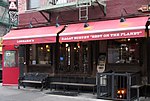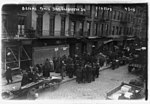San Lorenzo Ruiz Chapel (New York City)
20th-century Roman Catholic church buildings in the United StatesChristian organizations established in 1925Christian organizations established in 1995Christian organizations established in 2005Filipino-American culture in New York City ... and 5 more
NolitaRoman Catholic Archdiocese of New YorkRoman Catholic chapels in the United StatesRoman Catholic churches completed in 1926Roman Catholic churches in Manhattan

The Chapel of San Lorenzo Ruiz was a Roman Catholic chapel in the Roman Catholic Archdiocese of New York, located at 378 Broome Street between Mulberry and Mott Streets in the Nolita neighborhood of Manhattan, New York City. The chapel was established in 2005. The building was originally constructed for the Church of the Most Holy Crucifix in 1925–26, and was designed by Robert J. Reiley.The chapel is designated for the Filipino Apostolate of the Archdiocese. It was named as the official "Church of Filipinos" by Archbishop Edward Cardinal Egan on June 15, 2005.
Excerpt from the Wikipedia article San Lorenzo Ruiz Chapel (New York City) (License: CC BY-SA 3.0, Authors, Images).San Lorenzo Ruiz Chapel (New York City)
Broome Street, New York Manhattan
Geographical coordinates (GPS) Address External links Nearby Places Show on map
Geographical coordinates (GPS)
| Latitude | Longitude |
|---|---|
| N 40.720444444444 ° | E -73.996333333333 ° |
Address
San Lorenzo Ruiz Chapel
Broome Street 378
10012 New York, Manhattan
New York, United States
Open on Google Maps







